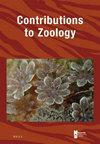从壳里爬出来还是爬回去:双壳和海鞘相关虾的分支中多个门间宿主转换事件(纲:对虾科)
IF 2.2
2区 生物学
Q1 ZOOLOGY
引用次数: 6
摘要
海洋共生的古线虫科有600多种,与不同门的海洋无脊椎动物如刺胞动物、棘皮动物、软体动物、多孔动物和被膜动物生活在一起。使用形态学和分子数据对双壳类和海鞘类相关的内共生虾种(虾科:虾科)进行了系统发育研究。为了在进化框架中包括所有目前已知的群内物种,使用了全证据方法。进行祖先状态重建分析以识别主机切换事件和祖先范围。该支系,包括海鞘纲、贝壳纲、长爪纲、齿形纲和Pontonia,以及各种较小的属,被恢复为单系,具有与海鞘相关的祖先寄主状态。至少有6种种间寄主转换被初步确定,在包括贝壳纲、齿形纲和相关属在内的进化枝的祖先寄主转换后,齿形纲和Notopontonia的成员从海鞘类寄主切换到双壳类寄主。包括Ascidonia和Pontonia在内的进化支被发现有一个东太平洋/大西洋分布的祖先。另一个被研究的属仍然在原始的祖先印度-西太平洋范围内。我们假设,不同门的虾宿主的相似内部环境将成为各种共生体谱系中门间宿主转换的热点。本文章由计算机程序翻译,如有差异,请以英文原文为准。
Coming out of your shell or crawling back in: multiple interphylum host switching events within a clade of bivalve- and ascidian-associated shrimps (Caridea: Palaemonidae)
Marine symbiotic Palaemonidae, comprising over 600 species, live in association with marine invertebrates of different phyla, like Cnidaria, Echinodermata, Mollusca, Porifera, and Tunicata. A phylogenetic study is performed on a clade of bivalve- and ascidian-associated endosymbiotic shrimp species (Caridea: Palaemonidae), using morphological and molecular data. A Total Evidence approach is used in order to include all currently known ingroup species in an evolutionary framework. Ancestral state reconstruction analyses are performed to identify host-switching events and ancestral ranges. The clade, including Ascidonia, Conchodytes, Dactylonia, Odontonia, and Pontonia, and various smaller genera, is recovered as monophyletic, with an ascidian-associated ancestral host state. At least six interphylum host switches are tentatively identified, with members of Odontonia and Notopontonia switching back to an ascidian host affiliation after the ancestral host switch of the clade including Conchodytes, Odontonia and related genera, from an ascidian- to a bivalve host. The clade including Ascidonia and Pontonia was recovered to have an ancestor with an East Pacific/Atlantic distribution. The other studied genera remained in the original ancestral Indo-West Pacific range. We hypothesize that similar internal environments of shrimp hosts from different phyla will function as hot spots for interphylum host switching in various lineages of symbionts.
求助全文
通过发布文献求助,成功后即可免费获取论文全文。
去求助
来源期刊

Contributions to Zoology
生物-动物学
CiteScore
4.00
自引率
4.50%
发文量
16
审稿时长
>12 weeks
期刊介绍:
Contributions to Zoology solicits high-quality papers in all systematics-related branches of comparative zoology (including paleozoology). Preference will be given to manuscripts dealing with conceptual issues and to integrative papers (e.g., ecology and biodiversity, morphology and phylogeny and character state evolution, phylogeny and historical biogeography, systematics and bioinformatics, bioinformatics and biodiversity, habitat disturbance and biogeography, etc.). Reviews and alpha-taxonomic contributions are considered for publication, but acceptance will depend on their high quality and exceptional nature.
 求助内容:
求助内容: 应助结果提醒方式:
应助结果提醒方式:


